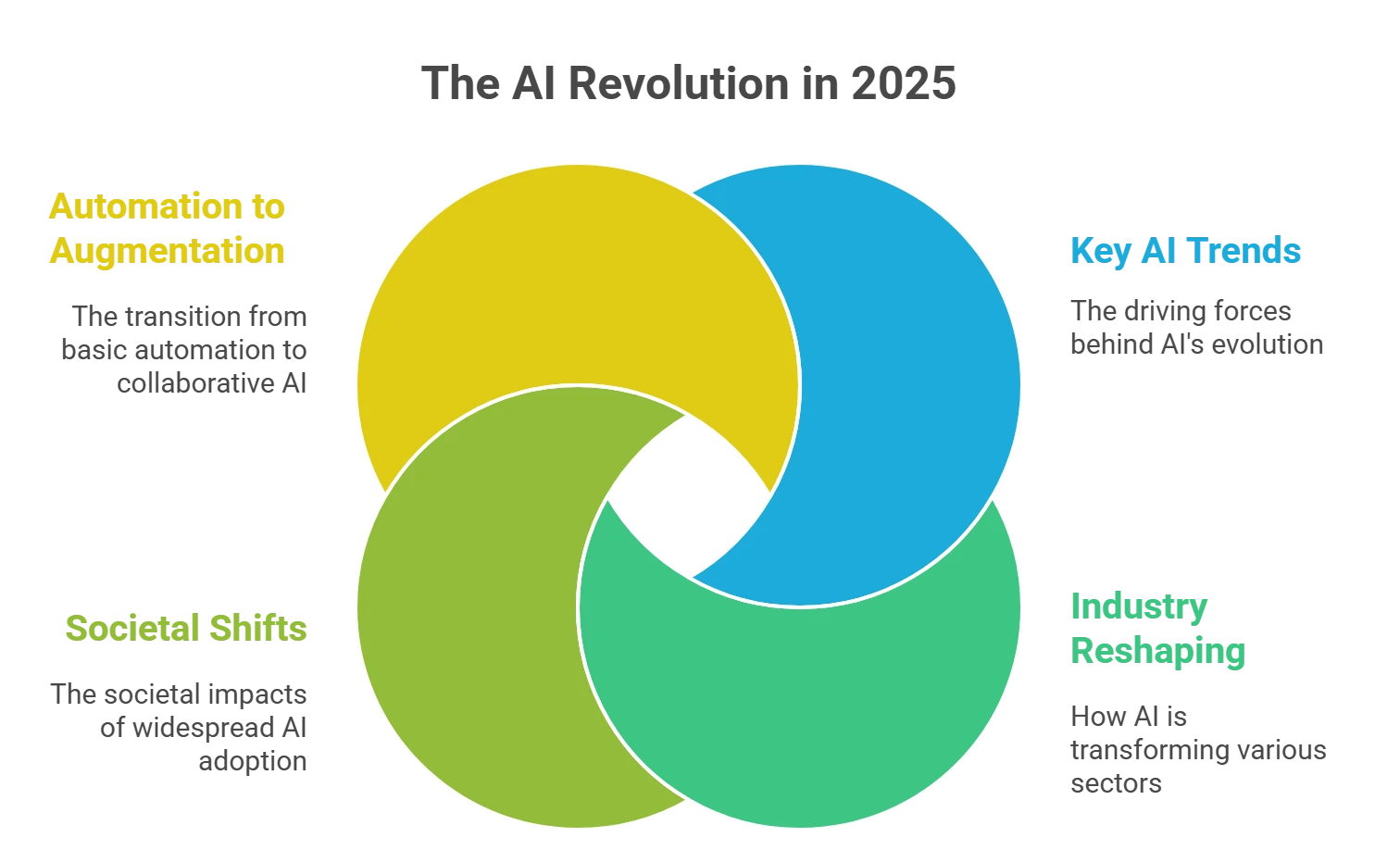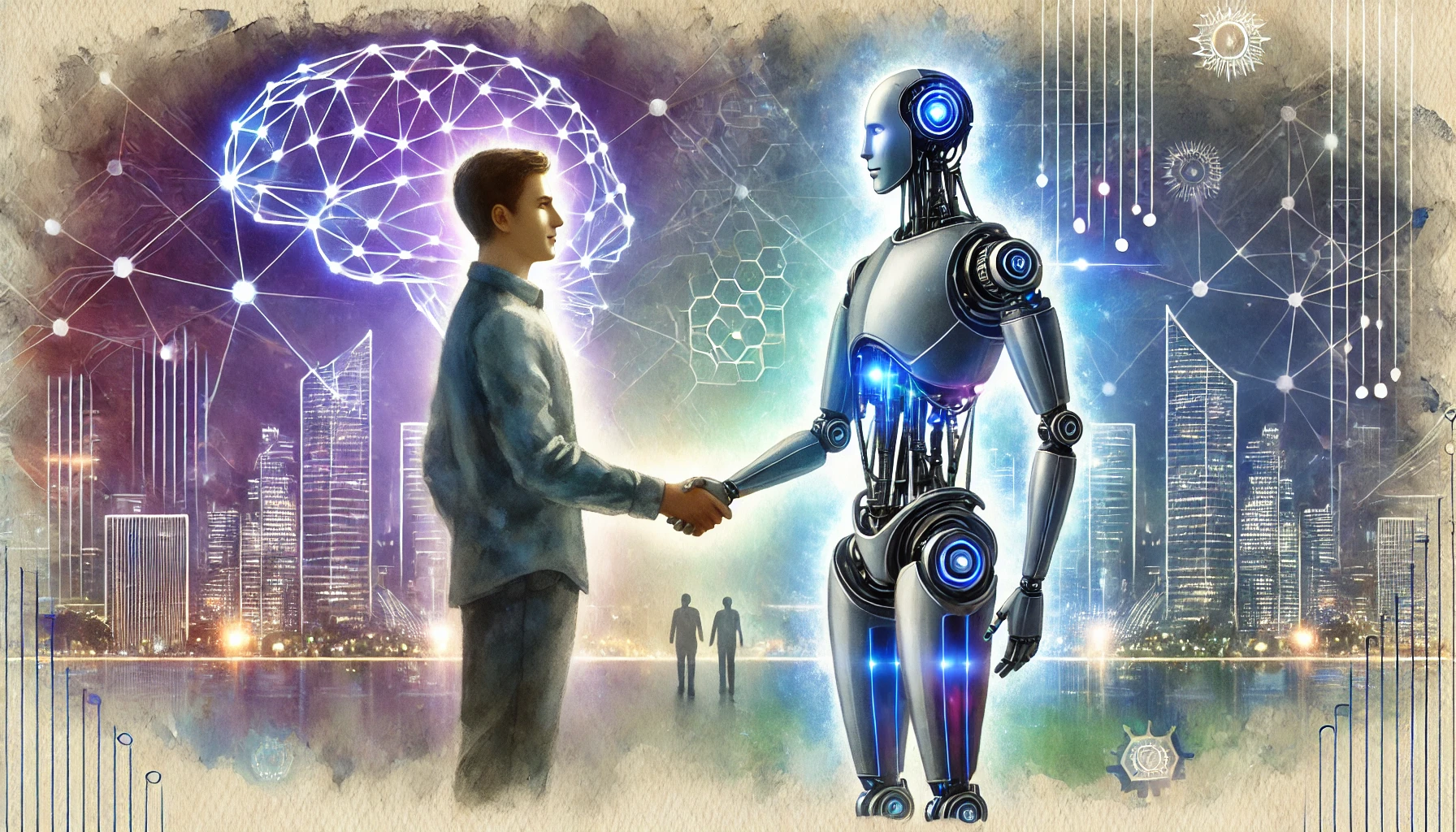In 2025, over 80% of global enterprises use AI in daily operations — not just to automate, but to think, plan, and decide alongside humans.
The future isn’t on the horizon anymore — it’s here. Artificial Intelligence in 2025 is not just advancing quietly in the background; it has exploded into every corner of our personal and professional lives. From creative content to healthcare diagnostics, smart assistants to autonomous agents, AI is no longer confined to labs or tech startups. It’s in classrooms, offices, homes, hospitals, and everywhere in between.
So, what makes 2025 a true turning point? This is the year AI transitioned from being a helpful tool to becoming a deeply integrated collaborator. With the rise of “agentic” AI, generative multimodal models, edge computing, and real-time decision-making, AI now understands, reasons, and responds more like a human than ever before — and often faster and more efficiently.
In this blog, you’ll get a clear, comprehensive breakdown of:
- The 6 key AI trends dominating 2025
- How these technologies are reshaping industries, jobs, education, and creativity
- The societal shifts — both promising and problematic — that AI is driving
- A snapshot of how AI has moved from automation to full-blown augmentation

The State of AI in 2025: An Overview
Artificial Intelligence in 2025 is woven into the fabric of modern life. It doesn’t just assist — it adapts, anticipates, and acts. AI drives decision-making in businesses, powers diagnostics in healthcare, personalizes education, supports creativity, and even helps governments shape policy. It’s embedded in our devices, cloud systems, and even on the edge — in homes, cars, factories, and wearable tech.
Three core transformation themes define this era:
1. Ubiquity
AI is everywhere. It’s no longer siloed in tech departments. From retail to research labs, it’s part of every digital touchpoint, every user experience, and every strategic plan.
2. Intelligence
Modern AI doesn’t just process data — it reasons through it. With multimodal capabilities and advanced cognitive architectures, today’s systems can analyze, contextualize, and solve complex, real-world problems.
3. Impact
AI is creating ripple effects across society. It’s redefining the meaning of work, reshaping healthcare outcomes, challenging creative norms, and raising new ethical questions. The influence of AI is cultural, economic, and deeply personal.
“AI is no longer a tool. It’s a partner.”
Whether you’re a business leader, creative, educator, policymaker, or simply curious — understanding AI in 2025 means understanding the new rules of innovation, productivity, and collaboration.
6 Defining Trends Reshaping AI in 2025
➤ A. Rise of the AI Agent
What it is:
2025 marks the widespread adoption of agentic AI — systems that act autonomously, plan ahead, and complete complex tasks without step-by-step commands. These AI agents don’t just react; they initiate.
Real-world applications:
- Smart business agents managing scheduling, research, and communication
- Personal home assistants that learn routines and anticipate needs
- AI-driven virtual employees operating across customer support, finance, and logistics
Why it matters:
AI is no longer passive. These agents amplify productivity, reduce human cognitive load, and allow users to delegate entire workflows. In both homes and offices, humans now collaborate with AI — a concept known as superagency — where decision-making is shared and accelerated.
➤ B. Generative AI Goes Fully Mainstream
What it is:
Generative AI — capable of producing text, code, visuals, music, and even synthetic voices or videos — is now an integral part of everyday life and work. It’s no longer experimental; it’s a creative and operational engine.
Real-world applications:
- AI-generated content in advertising, social media, game development
- AI writing assistants in journalism, marketing, and education
- On-demand content creation in entertainment and e-learning platforms
Why it matters:
AI content creation enables mass personalization, speeds up production, and reduces costs. In health, education, and entertainment, people now interact with content that adapts to their behavior, preferences, and needs in real time — reshaping engagement and expectation.
➤ C. Multimodal Intelligence and Better Reasoning
What it is:
Today’s AI models can understand and generate text, audio, images, and video, creating a seamless cross-medium experience. Combined with multi-step reasoning, they solve problems in a more human-like, contextual way.
Real-world applications:
- Medical AI that combines imaging, patient history, and genetic data for diagnosis
- Customer service bots that analyze voice, facial expressions, and queries together
- Research assistants that summarize, compare, and validate data across formats
Why it matters:
This evolution closes the gap between machine understanding and human cognition. AI is no longer guessing — it’s reasoning. That means fewer errors, deeper insights, and more natural interactions across industries from medicine to law.
➤ D. Edge AI and Custom Hardware
What it is:
Edge AI refers to AI that runs locally on devices — smartphones, medical equipment, smart vehicles — instead of relying on cloud servers. At the same time, custom-built chips are enabling faster and more efficient AI operations.
Real-world applications:
- Real-time diagnostics in wearable health tech
- Autonomous vehicles processing data on the spot
- Smart factories using local AI for quality control and safety
Why it matters:
With growing privacy concerns and demand for low-latency response, AI at the edge is essential. Combined with the silent silicon revolution, this makes AI more secure, scalable, and responsive — pushing innovation closer to the user.
➤ E. Enterprise AI & Cloud Reformation
What it is:
AI has become a core business strategy. It’s not just IT’s job anymore — every department, from HR to finance to R&D, now uses AI. Meanwhile, cloud infrastructure is evolving specifically to support AI workloads.
Real-world applications:
- Predictive analytics for customer behavior and market trends
- AI-led cybersecurity and fraud detection
- Customized enterprise AI models deployed on AI-optimized cloud platforms
Why it matters:
AI is the engine of competitiveness. Organizations that integrate AI deeply are achieving higher productivity, faster innovation, and more adaptive operations — transforming how companies grow and scale.
➤ F. Ethical AI and Regulation
What it is:
With AI’s power comes growing concern. In 2025, regulatory frameworks and ethical standards are rapidly evolving to ensure AI is developed and deployed responsibly.
Real-world applications:
- Government-mandated transparency for AI decision-making
- Global collaborations on ethical AI principles
- AI audits to detect bias or unfair treatment in algorithms
Why it matters:
Trust is the currency of modern AI. Without transparency, accountability, and human rights protections, AI adoption risks public backlash. Strong ethics ensure that AI serves humanity, not just profits or politics.
Societal Impact: AI at the Human Level
➤ A. Education: The Personalized Classroom
AI tutors, adaptive curricula:
Students in 2025 learn with the help of AI-powered tutors that adjust content in real time based on comprehension and learning style.
Accessibility and equity:
Remote areas and underserved communities now access high-quality education through AI, helping to close global learning gaps and democratize knowledge.
➤ B. Jobs & Work: Productivity or Displacement?
Task automation vs. job evolution:
AI takes over routine and analytical tasks, allowing humans to focus on creative, strategic, or emotional work. But it also displaces certain roles, especially in admin-heavy industries.
Specialist vs. generalist roles:
In the AI age, generalists equipped with AI tools can now do what once required specialist teams — shifting the definition of expertise and career paths.
➤ C. Healthcare: A New Era of Diagnosis and Treatment
Early detection and precision medicine:
AI identifies patterns in genetic data, imaging, and symptoms earlier than ever — improving outcomes for diseases like cancer, Alzheimer’s, and heart disease.
Real-time diagnostics and care:
Edge AI in wearables and monitoring systems enables continuous, personalized health tracking, improving both prevention and treatment at scale.
➤ D. Creativity: Empowerment or Erosion?
AI as co-creator:
From screenplays to symphonies, AI now collaborates with artists, offering inspiration, structure, and even finished works.
The originality dilemma:
As AI blurs the lines between human and machine-made art, debates about copyright, ownership, and authenticity are intensifying.
➤ E. Disinformation & Deepfakes: The Double-Edged Sword
Content distortion risks:
With AI capable of creating ultra-realistic fake videos, voices, and images, trust in media is under siege.
The counterattack:
In response, 2025 has seen the rise of content authentication tools, digital watermarking, and regulatory mandates for synthetic content disclosure.
Global Landscape: The Race for AI Supremacy
➤ U.S. vs. China: Competition, Cooperation, and Tension
The United States and China remain at the forefront of the global AI race in 2025 — dominating in large language models, patents, investment, and talent acquisition. Both nations are aggressively advancing AI R&D, integrating AI into military systems, education, manufacturing, and state infrastructure.
Yet, even amid fierce technological competition, there’s a layer of interdependence and collaboration:
- U.S. chipmakers supply China with AI hardware (albeit under restrictions)
- Chinese companies contribute to foundational model performance benchmarks
- Cross-border academic collaborations persist, particularly in healthcare AI and safety research
The result is a dynamic of rivalry layered with strategic cooperation — shaping global standards and geopolitical narratives.
➤ The Rise of Regional Innovators
While the U.S. and China dominate headlines, regional AI powerhouses are emerging fast:
- Europe leads in AI governance and regulation, pioneering ethical standards and transparency mandates
- India is scaling AI in agriculture, language translation, and fintech for rural development
- The UAE, Singapore, and South Korea are becoming global testbeds for smart cities and AI-first government services
These countries demonstrate that AI leadership isn’t just about scale — it’s about specialization, adaptability, and vision.
➤ Global Collaboration and Digital Sovereignty
2025 is also defined by a paradox:
The world is more connected through AI, but also more protective of data, algorithms, and infrastructure.
Nations are asserting digital sovereignty, ensuring that local laws, values, and economies aren’t dictated by foreign tech giants. At the same time, multilateral cooperation is growing around:
- AI safety and alignment standards
- Cross-border regulation of misinformation and synthetic media
- Responsible AI deployment in climate science, disaster relief, and public health
AI is becoming both a shared global resource and a national strategic asset, and the balance between openness and protection is still evolving.
What This All Means: A New Social Contract

➤ Opportunities: Democratization, Empowerment, Efficiency
Artificial Intelligence in 2025 offers unprecedented potential:
- Access to world-class education, healthcare, and knowledge is no longer limited by geography or privilege
- Individuals and small businesses can now harness tools once reserved for tech giants — boosting innovation at the edges
- Governments and enterprises operate with new levels of insight and efficiency, unlocking faster problem-solving and smarter public policy
AI is not just an elite tool — it is becoming a democratizing force, amplifying human potential at scale.
➤ Challenges: Equity, Ethics, Existential Questions
But with great power comes deep tension:
- Will job automation widen inequality or uplift everyone through new roles?
- Can AI decisions ever truly be fair, or will algorithmic bias deepen discrimination?
- As AI systems become more autonomous and intelligent, what defines humanity’s unique role in the loop?
These are not technical questions alone — they are social, philosophical, and political.
➤ What Governments, Industries, and Citizens Must Prepare For
The road ahead demands bold, unified responses:
- Governments must invest in digital literacy, establish robust safety nets for displaced workers, and lead in ethical regulation
- Industries need to design for transparency, accessibility, and accountability — not just speed and scale
- Citizens must become active participants, not passive users — asking questions, setting boundaries, and shaping how AI is used in their communities
In short: AI in 2025 is a turning point, not just in technology, but in how we govern, relate, and evolve as a society.
Summary Table: AI in 2025 at a Glance
This table provides a quick reference to the core advances and societal effects of AI in 2025, summing up the transformation across sectors and domains.
| Domain | Key Advances | Societal Impact |
| AI Agents | Autonomous, multimodal, collaborative | Workflow transformation |
| Healthcare | Early diagnosis, precision medicine | Personalized care |
| Work | Task automation, agentic workflows | Job disruption & efficiency |
| Enterprise | AI-first strategy, optimized hardware | Innovation & competitive edge |
| Creativity | Generative tools, co-creation | Expression + legal challenges |
| Edge AI | Privacy-focused local computation | Real-time decisions, safety |
| Regulation | Ethics frameworks, global policy | Responsible innovation |
Final Thoughts: Living with AI, Leading with Purpose
2025 is the year AI stopped being a future concept and became part of our everyday reality. From creative expression to life-saving diagnostics and decision-making at scale, artificial intelligence is no longer just augmenting human capability — it’s shaping how we live, work, and relate to one another.
As we look ahead, the question isn’t just what AI can do, but how we choose to design and govern it.
➤ Human-Centric AI Is Not Optional — It’s Essential
True progress means aligning AI systems with human values, diversity, and rights — not just performance benchmarks. Design choices today will define the social contract of tomorrow.
To lead with purpose, we must:
- Prioritize transparency and accountability
- Embed fairness and inclusivity at the system level
- Ensure everyone—not just a few—benefits from AI’s rise
➤ A Call to Action
Whether you’re a student, creator, business owner, policymaker, or everyday user, you’re part of the AI conversation now.
✅ Stay informed — Follow credible AI news and research
✅ Stay involved — Question, test, and speak up about the AI tools around you
✅ Stay ethical — Let your voice shape a future where intelligence enhances dignity, not replaces it
AI is not destiny — it’s a design challenge. And we all have a hand in building it.
Sources and Further Reading
Here’s a curated list of key sources referenced throughout the article. These provide a deeper look at the trends, challenges, and opportunities shaping AI in 2025:
🧠 Top 5 Reads to Go Deeper:
- Stanford HAI — 2025 AI Index Report
- Morgan Stanley — 5 AI Trends Shaping Innovation and ROI in 2025
- Microsoft — 6 AI Trends You’ll See More of in 2025
- McKinsey — Superagency in the Workplace
- Forbes — Five Transformative AI Trends Shaping 2025
🔍 Additional Resources:
- IBM — AI Agents in 2025: Expectations vs. Reality
- UNCTAD — Technology and Innovation Report 2025
- AWS Dev.to — Key AI Trends for 2025
- LinkedIn Pulse — The Impact of AI on Society in 2025
- Nexford — How AI Will Affect Jobs (2025–2030)
FAQ: AI in 2025 – Your Questions Answered
1. What is the biggest change in AI between 2020 and 2025?
The biggest shift is that AI has gone from a behind-the-scenes tool to an active digital partner. In 2025, AI doesn’t just automate — it plans, reasons, collaborates, and personalizes. Technologies like agentic AI, multimodal systems, and edge computing have made AI more intelligent, human-like, and accessible than ever.
2. How is AI affecting jobs in 2025?
AI is transforming work by automating repetitive tasks and assisting with complex ones. While it boosts productivity, it also causes job displacement in some sectors. At the same time, new roles are emerging that require AI literacy, and generalists empowered by AI can perform specialist-level tasks.
3. Is AI dangerous or beneficial to society in 2025?
It’s both — depending on how it’s built and used. On one hand, AI enhances healthcare, education, and creativity. On the other, it poses risks like misinformation, bias, and ethical concerns. That’s why regulation and responsible design are more critical than ever.
4. What are “AI agents” and why do they matter?
AI agents (or “agentic AI”) are digital assistants that act independently — they can plan, take initiative, and solve problems with minimal human input. They’re essential in 2025 because they streamline work, boost decision-making, and collaborate with humans as digital teammates.
5. How can I stay informed and prepare for AI’s future?
Start by following reputable AI news sources, learning basic AI concepts, and understanding the tools you use daily. Whether you’re a student, professional, or creator, AI literacy is a must-have skill. Staying engaged means you’ll be part of the conversation — and the solution.





[…] What does AI look like in 2025? […]